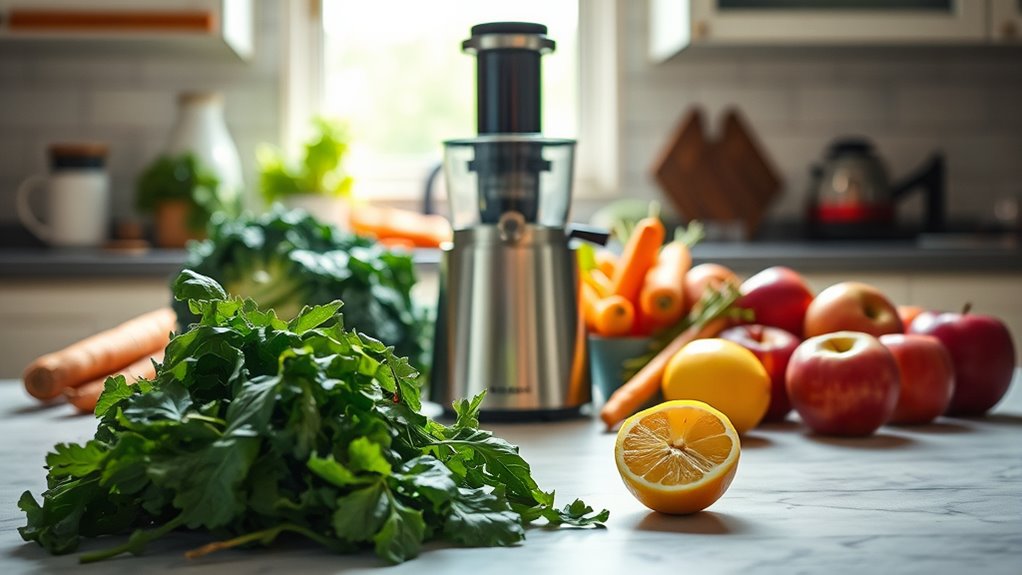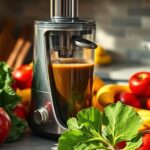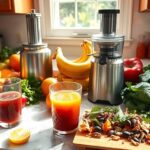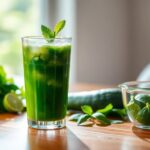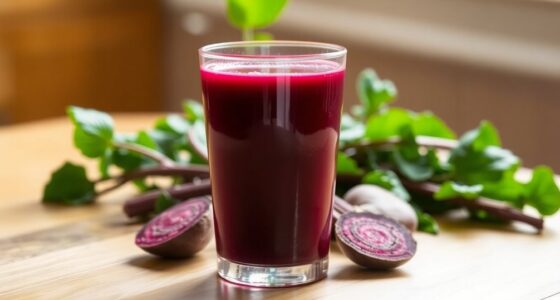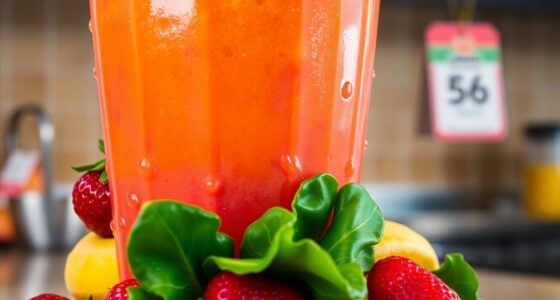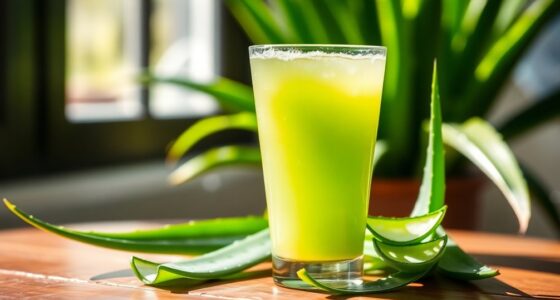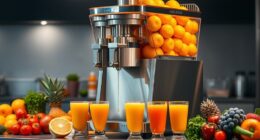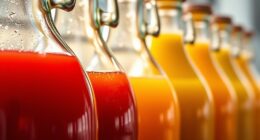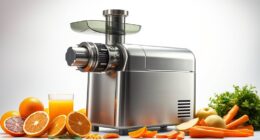One major juicing mistake that could cost your health is drinking juice on a full stomach. This can hinder vitamin absorption and lead to digestive issues. Plus, if you’re not balancing your juice with enough vegetables, you might overload on sugars from fruit. Remember, freshly squeezed juice is best consumed on an empty stomach for ideal digestion. Want to know more about ensuring your juicing supports your health? Keep going to uncover essential tips!
Key Takeaways
- Drinking juice on a full stomach can hinder vitamin absorption and lead to digestive issues.
- Consuming juice with a high fruit-to-vegetable ratio increases sugar content, which can disrupt blood sugar levels.
- Improper storage of juice allows oxidation, resulting in nutrient loss and reduced health benefits.
- Not washing produce thoroughly can expose you to harmful contaminants like E. coli and Salmonella.
- Drinking juice too quickly can cause stomach discomfort and bloating, affecting overall enjoyment and digestion.
Understanding the Impact of Juicing on Health
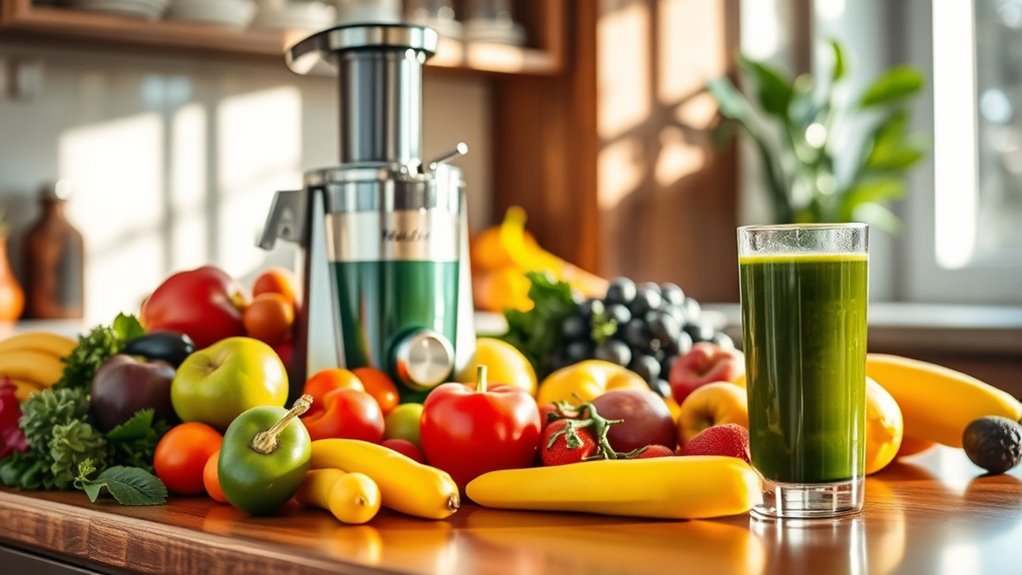
When you consider juicing as a health option, it’s important to understand its impact on your body.
Juicing can offer health benefits, but it’s crucial to recognize its effects on your body.
While a juicing routine can provide nutrients from the juice, it often comes with high sugar content that can lead to health issues. Without the fiber found in whole foods, you’re not only missing out on gut health benefits, but you might also encourage sugar-loving bacteria to thrive.
This can disrupt your microbiome and increase inflammation, which negatively affects your metabolism, immunity, and even mental health. Additionally, prolonged juice diets can lead to nutrient deficiencies if not balanced properly.
To maximize the benefits, it’s important to pair your juices with whole foods. This way, you can enjoy the nutrients while mitigating the adverse effects of sugar overload, ensuring a balanced approach to your health.
The Role of Fiber in a Healthy Diet
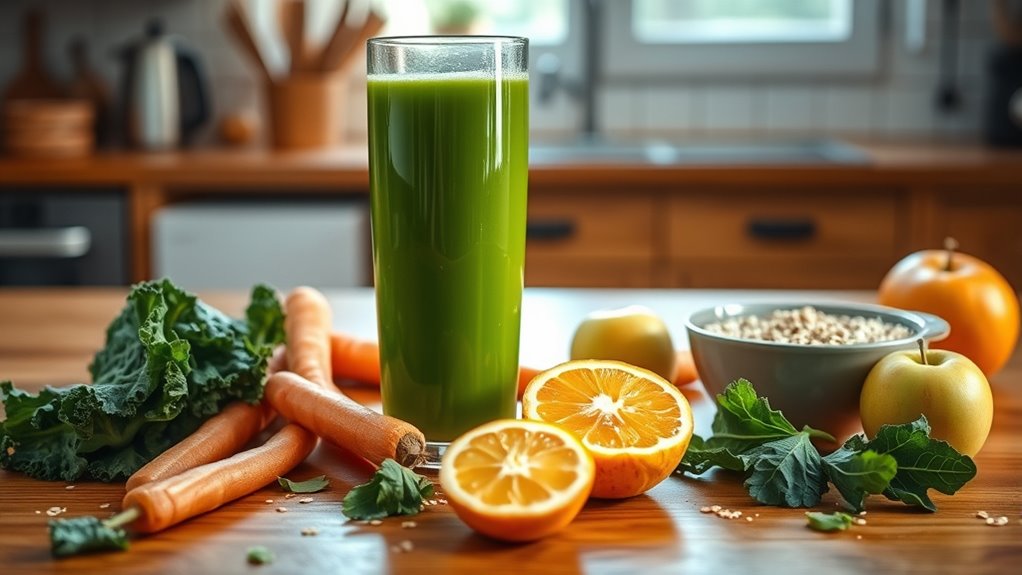
While many people focus on vitamins and minerals in their diets, fiber often gets overlooked despite its essential role in maintaining overall health. It regulates digestion, prevents constipation, and helps control blood sugar levels. A diet rich in fiber, found in fruits and vegetables, offers numerous health benefits, including a lower risk of heart disease and stroke. Additionally, incorporating high-fiber foods like baked kale can further enhance digestive health and provide essential nutrients.
| Source | Fiber Content (grams) | Health Benefits |
|---|---|---|
| Apples | 4 | Supports gut health |
| Broccoli | 5 | Lowers cholesterol |
| Lentils | 15 | Stabilizes blood sugar |
| Whole grains | 6-8 | Reduces heart disease risk |
| Avocado | 10 | Provides anti-inflammatory compounds |
Avoid relying on processed foods; instead, increase your fiber intake for better health!
Common Juicing Mistakes to Avoid
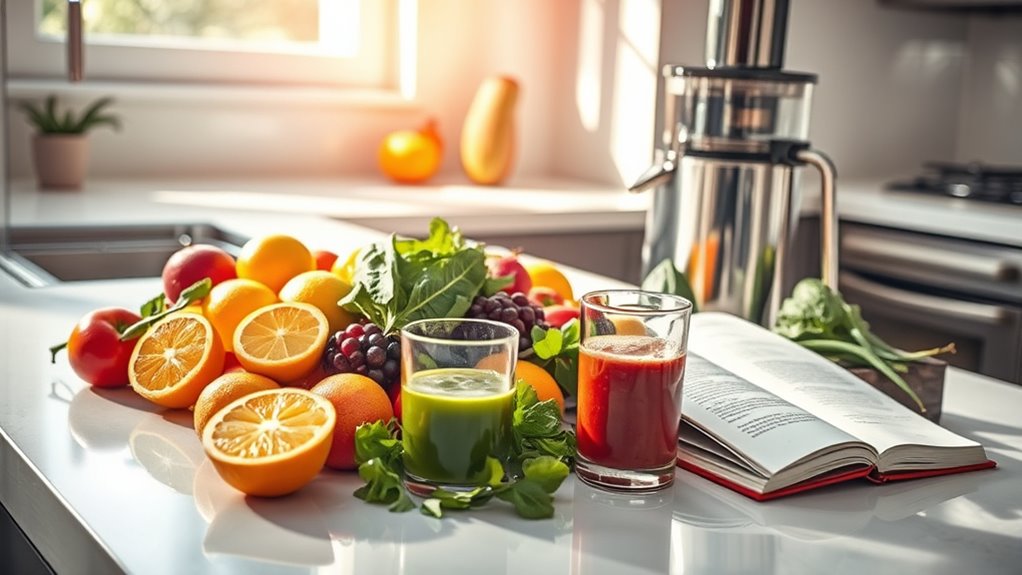
Fiber is important for your health, and so is how you juice. One common mistake is drinking juice on a full stomach; it hinders vitamin absorption.
Try juicing on an empty stomach and waiting two hours post-meal. Another mistake is using too much fruit, which raises sugar content. Aim for a 70% vegetable to 30% fruit ratio for better health benefits.
Juicing on an empty stomach and balancing fruit and vegetable ratios enhances nutrient absorption and health benefits.
When it comes to storing juice, don’t leave it at room temperature or in loosely sealed containers; this leads to oxidation and nutrient loss. Consume fresh juice within 15 minutes or store it in the coldest part of your fridge.
Finally, clean your juicing equipment immediately to avoid bacterial growth and maintain juice quality.
The Importance of Washing Your Produce
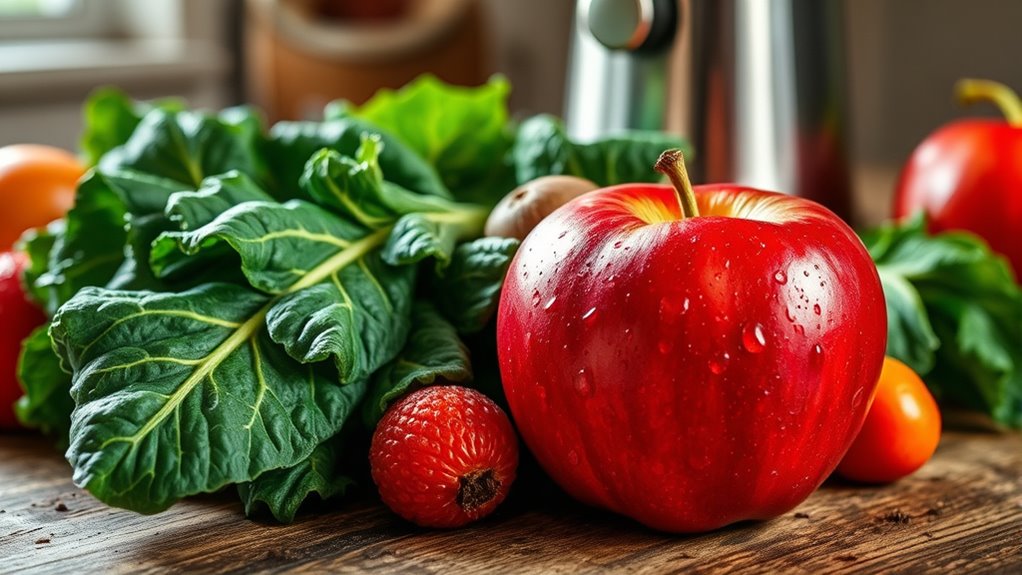
When you juice, washing your produce isn’t just a suggestion; it’s vital for your health.
Contaminants and bacteria can easily cling to fruits and veggies, so using proper washing techniques helps guarantee a safer drink.
If you choose organic produce, remember that it still needs a good rinse to maximize the benefits of your juice. Additionally, washing your fruits and vegetables helps remove high levels of pesticides, ensuring a healthier juice for consumption.
Contaminants and Bacteria Risks
To guarantee your juice is as healthy as possible, it’s essential to wash your produce thoroughly. Neglecting to do so can expose you to harmful contaminants and bacteria like E. coli and Salmonella. Leafy greens are especially vulnerable due to their farming conditions, while all produce can carry pesticide residues. Here’s a quick look at the risks:
| Produce Type | Contaminant Risks |
|---|---|
| Leafy Greens | E. coli, Salmonella |
| Berries | Pesticides, Bacteria |
| Root Vegetables | Soil Bacteria |
| Apples | Pesticide Residues |
| Tomatoes | E. coli, Pesticides |
Washing produce not only removes bacteria but also enhances the health benefits of your juice. Additionally, incorporating ingredients like chia seeds can further boost your juice’s nutritional profile. Prioritize safety for your health!
Proper Washing Techniques
While you might think rinsing your fruits and vegetables is enough, proper washing techniques are essential for ensuring your juice is safe and nutritious. Simply rinsing can leave harmful bacteria like E. coli and Salmonella, especially on leafy greens, which thrive in contaminated areas.
To enhance your fresh juice’s health benefits, apply friction while washing; this can remove up to 80% of surface pesticide residues. Consider soaking your produce in a baking soda solution for additional cleansing. Additionally, using essential oils like tea tree oil can provide natural antibacterial properties that further enhance the cleanliness of your produce.
Using resources like the Dirty Dozen/Clean 15 list from EWG.org can help you make safer choices. Neglecting these washing techniques not only raises the risk of gastrointestinal issues but also compromises the nutritional quality of your juice.
Make washing a priority!
Importance of Organic Produce
Choosing organic produce can greatly enhance the quality of your juices. However, even organic fruits and vegetables can harbor harmful bacteria and pesticide residues, making it crucial for you to wash produce thoroughly.
Contaminants like E. coli or Salmonella can linger, especially on leafy greens near cattle feedlots. To guarantee safety, run your produce under hot water while using friction to remove bacteria and up to 80% of pesticides.
A baking soda soak—one tablespoon per salad spinner-sized bowl—can further help eliminate surface residues. By understanding the importance of washing your produce, you’ll reduce the risk of gastrointestinal issues and boost the nutritional quality of your juices, ultimately promoting better health. Additionally, consuming nutrient-rich ingredients can enhance the detoxification benefits of your juice cleanse.
Balancing Fruits and Vegetables in Juicing
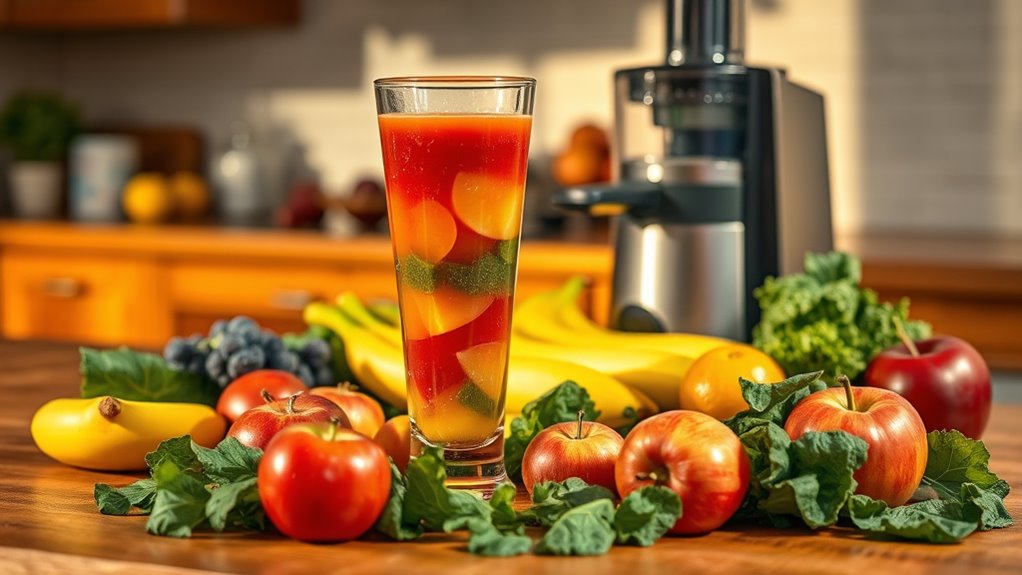
Balancing fruits and vegetables in your juice is crucial for maximizing health benefits while keeping sugar levels in check. Aim for a ratio of 70% vegetables to 30% fruits, or 40% fruits to 60% vegetables. This helps avoid excessive sugar intake and supports your weight loss goals.
- Leafy greens like kale and spinach offer essential nutrients without added sweetness.
- A balanced blend guarantees a variety of vitamins and antioxidants.
- Reducing fruit content in juices for kids helps maintain steady energy levels.
- Juicing correctly can minimize cravings for sweet flavors.
Incorporating chia seeds into your juices can enhance the nutritional profile, providing omega-3 fatty acids and fiber.
Timing Your Juice Consumption for Optimal Benefits
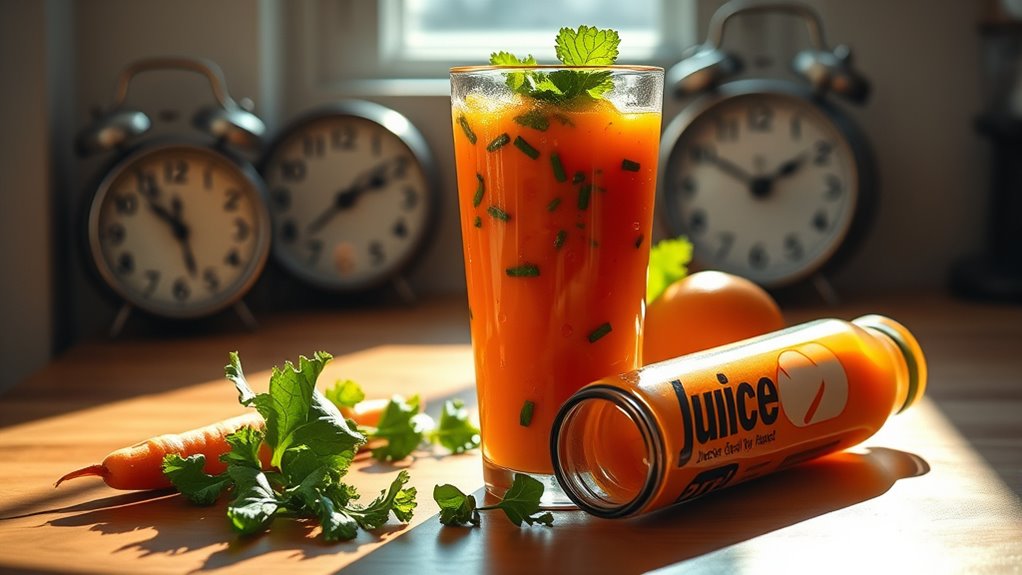
To get the most out of your juice, drink it on an empty stomach. This boosts nutrient absorption and can even curb cravings for unhealthy foods. Timing your juice right, like having it first thing in the morning, sets a positive tone for your day. Additionally, drinking freshly squeezed juice can provide more nutrients than processed options, enhancing your overall health.
Empty Stomach Benefits
Starting your day with juice on an empty stomach can greatly improve the absorption of essential nutrients. When you consume juice first thing in the morning, your body can utilize vitamins and minerals more effectively without interference from other foods.
This timing can also help kickstart your metabolism, providing a quick boost to your energy levels. Adding fresh herbs like mint or basil to your juice can further enhance its refreshing qualities and nutritional benefits.
- Supports ideal nutrient absorption
- Helps stabilize blood sugar levels
- Reduces cravings for unhealthy snacks
- Prepares your body for the day ahead
Wait at least two hours after a meal before drinking juice to avoid digestive issues like heartburn.
Additionally, waiting 20 minutes after juicing before eating ensures your body fully absorbs those nutrients, maximizing their benefits.
Meal Timing Guidelines
Timing your juice consumption is crucial for maximizing its health benefits. To get the most out of your juice, drink it on an empty stomach.
Ideally, you should wait at least two hours after a meal before indulging in your fresh juice. This allows for optimal nutrient absorption and prevents digestive discomfort.
If you drink juice first thing in the morning, you’ll kickstart your day with a revitalizing energy boost. After having your juice, it’s best to wait 20 minutes before consuming a meal to guarantee your body absorbs all those essential nutrients effectively. Incorporating low carb high protein options in your breakfast can further enhance your energy levels throughout the day.
Following these meal timing guidelines can help you avoid spikes in blood sugar and enhance your overall digestive health.
Choosing the Right Juicer for Nutritional Quality
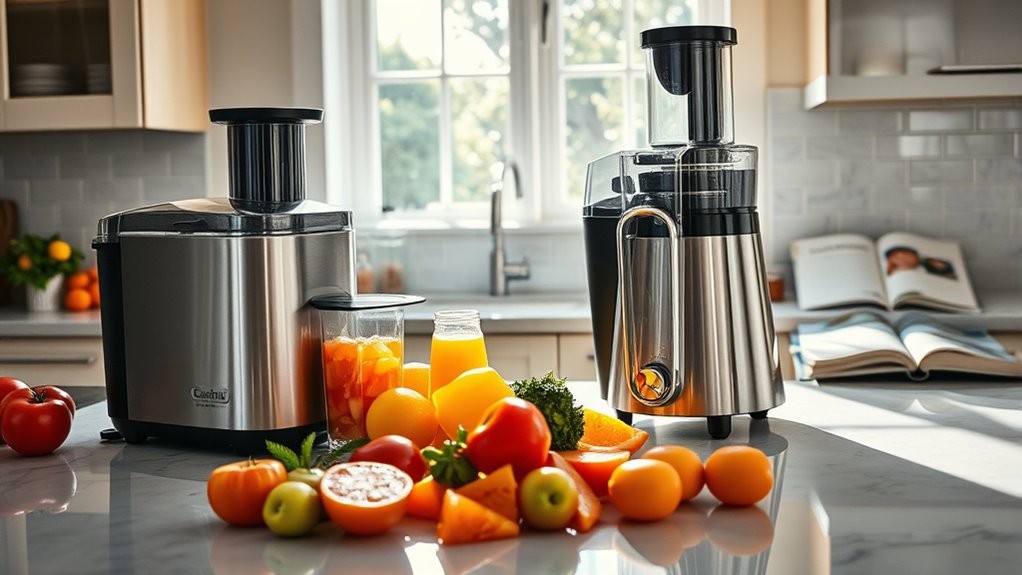
When you’re aiming to maximize the nutritional quality of your juice, the type of juicer you choose plays a pivotal role. Opting for a masticating juicer or cold-pressed juicer over a centrifugal juicer is essential.
Choosing the right juicer is crucial for maximizing juice nutrition; masticating or cold-pressed options are superior to centrifugal models.
Centrifugal juicers introduce heat and air, leading to oxidation and nutrient loss.
Consider these benefits when selecting your juicer:
- Masticating juicers operate at slower speeds, preserving enzymes and nutrients.
- Cold-pressed juicers can extend juice shelf life to over five days.
- Investing in quality equipment minimizes oxidation and maximizes juice extraction.
- Better juicers yield higher nutrients and antioxidants.
The Risks of Drinking Juice Too Quickly
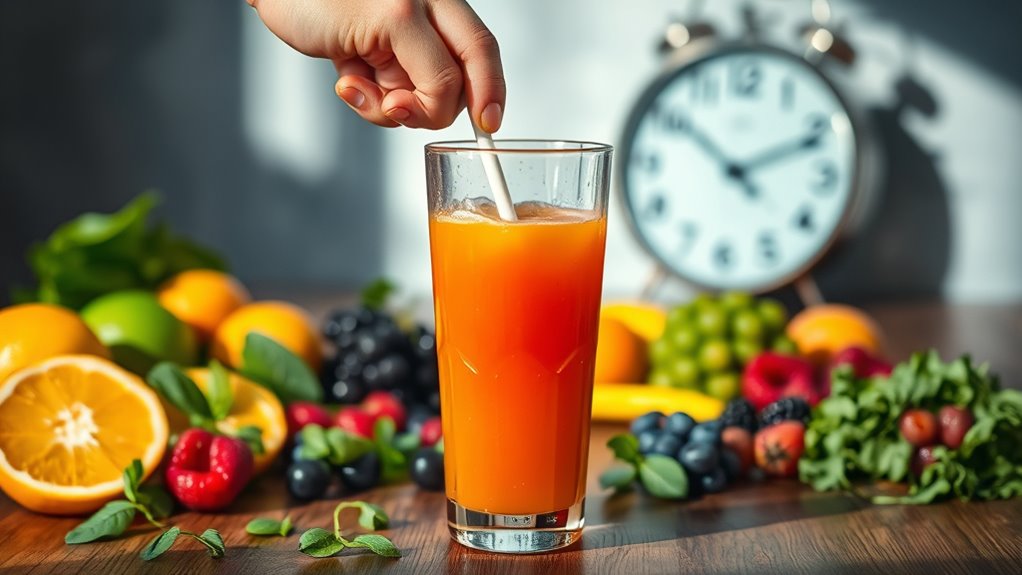
Even with the right juicer, how you consume your juice can considerably impact its health benefits. Drinking juice too quickly can lead to stomach discomfort and bloating, as your body struggles to digest and absorb the nutrients effectively.
Sipping your juice slowly promotes mindful consumption, allowing you to enjoy the flavors while enhancing nutrient absorption through saliva. It’s best to drink juice on an empty stomach, waiting at least two hours after a meal to avoid digestive issues and guarantee ideal nutrient absorption.
Proper Storage Techniques for Fresh Juice
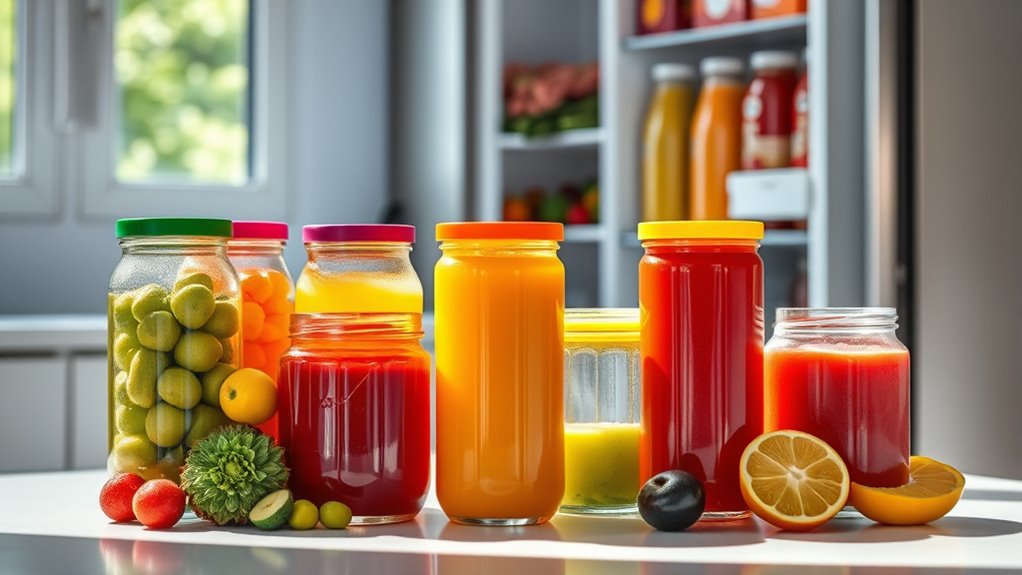
To keep your fresh juice packed with nutrients, it’s essential to store it properly. The way you handle your juice can greatly affect its shelf life and overall quality.
Proper storage is key to maintaining the nutrients in your fresh juice and enhancing its shelf life.
Here are some tips to guarantee you get the most out of your juice:
- Use an airtight container to minimize oxidation.
- Store your juice in the coldest part of the fridge, quickly chilling it below 41°F.
- Fill containers to the top to limit air exposure and preserve nutrients.
- Add lemon or lime juice for natural preservation, extending shelf life by up to two days.
Setting Realistic Goals for Your Juicing Journey

As you begin your juicing journey, it’s essential to define clear objectives that align with your overall wellness goals.
Tracking your progress will help you stay motivated and make necessary adjustments along the way.
Define Your Objectives
How can you make your juicing journey effective and enjoyable? Start by defining your objectives. Tailor your juice recipes to your health needs, especially if you need to limit sugar intake.
Here are some tips to help you set realistic goals:
- Begin with one juice per day instead of drastic juicing-only diets.
- Aim for a 70% vegetable to 30% fruit ratio to minimize sugar and support weight loss.
- Set a timeline, like a 3-day juice cleanse, followed by whole foods.
- Focus on long-term health improvements, like increased energy levels, rather than immediate results.
Track Your Progress
Establishing clear objectives sets a solid foundation, but tracking your progress takes your juicing journey to the next level.
As you start a juice-only diet or a juice cleanse, consider manageable goals like incorporating one juice per day. This gradual approach helps maintain motivation.
Track your progress by noting changes in energy levels, digestion, and overall health; these insights reveal the benefits of vitamins and minerals in your juices. Use a journal or app to log your recipes and health outcomes, keeping you accountable and informed.
Regularly reassess your goals to stay flexible and adapt to your body’s needs. This ongoing reflection enhances your juicing experience, making it more sustainable and rewarding.
Frequently Asked Questions
Can Juicing Cause Health Problems?
Yes, juicing can cause health problems. When you juice, you often strip away beneficial fiber, leading to higher sugar concentrations that might disrupt your gut microbiome.
If you consume juice on a full stomach, it can hinder nutrient absorption, negating potential benefits. Additionally, failing to wash your produce properly can expose you to harmful bacteria and pesticides, increasing the risk of gastrointestinal issues.
Be mindful of these factors to maintain your health while juicing.
What Is the 80 20 Rule in Juicing?
The 80/20 rule in juicing suggests you should aim for 80% vegetables and 20% fruits in your juice.
This balance helps keep your sugar intake low while maximizing nutrients. By focusing on leafy greens and other veggies, you get a variety of vitamins and minerals without the excessive sugars found in too many fruits.
Following this guideline can boost your energy levels and support your overall health goals more effectively.
What Happens to Your Body After 3 Days of Juicing?
After three days of juicing, you might notice some changes in your body.
You could experience weight loss from reduced calorie intake, but you risk nutrient deficiencies without whole foods.
Initially, you may feel energized from vitamins and minerals, but fluctuating blood sugar levels could lead to fatigue or irritability.
You might also face withdrawal symptoms if you’re used to processed foods.
While hydration improves, don’t forget the importance of fiber and water for digestion.
What Is One Downside About Juicing?
One downside of juicing is the removal of fiber, which your body needs for healthy digestion.
Without fiber, you might find yourself craving more food, as juices don’t provide the same satiety as whole fruits. This can lead to increased sugar intake, spiking your blood sugar levels.
Additionally, the lack of fiber can disrupt your gut microbiome, allowing harmful bacteria to thrive and potentially impacting your overall health negatively.
Conclusion
So, before you dive headfirst into your juicing journey, remember: it’s not just about what you juice, but how you do it. By avoiding common pitfalls and being mindful of your choices, you can truly harness the power of fresh produce. Don’t let a simple mistake cost you your health! Embrace balance, wash your ingredients, and savor the process. After all, a healthier you is just a glass away—are you ready to raise your glass?
Cindy thoroughly researches juicing trends, techniques, and recipes to provide readers with practical advice and inspiration. Her writing style is accessible, engaging, and designed to make complex concepts easy to understand. Cindy’s dedication to promoting the advantages of juicing shines through her work, empowering readers to make positive changes in their lives through the simple act of juicing.

